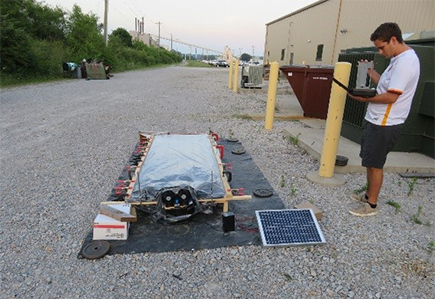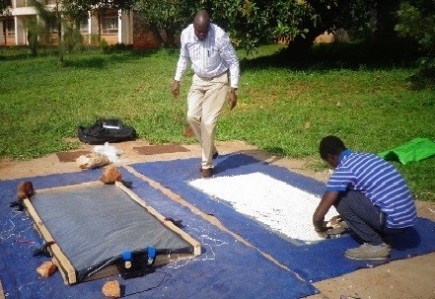Pico Solar Dryer
Purdue Collaborator: Agricultural and Biological Engineering, Mechanical Engineering


The Challenge:
Corn (maize), common beans (dried beans), rice, and cacao etc. are important cash crops for small-holder farms in sub-Saharan Africa, Central America and Asia. Because commercial grain dryers are often located far away and can be expensive to build and use, farmers prefer to dry the grain on their farms and then transport the dried grain to the farmer group collective. However, on-farm grain drying is usually performed manually by laying the grain in a thin layer on a tarpaulin and allowing it to dry in the sun. The current process has many disadvantages for smallholder farmers:
- Rain falling on the crop when it is drying or high ambient air relative humidity can make this process inefficient and unreliable.
- Inadequately dried corn does not fetch a good market price and leads to mold growth which can release mycotoxins, the most common in Africa being aflatoxin, a toxic and carcinogenic substance.
- Without manual labor to continually stir the grain (Fig. 1b), freshly harvested maize can take 3-4 days to dry on a tarp to the desired moisture content.
- Rodents and insects can easily access grain during open tarp drying.
Thus there is an interest among many stakeholders to consider the business case for a commercial solar dryer that can dry small batches of grain (100-500 kilos) faster than it can be dried on a tarp.
The Purdue Innovation:
The invention is a portable, extremely low-cost, energy efficient, battery powered crop dryer to dry 150 kilos of moist grains or seeds down to safe storage level. The battery can be charged with a small capacity “pico” photovoltaic panel (20-100 W).
Our design a simple “tuck under” method of making the drying plenum above the trays air tight.
It features two key patentable ideas:
- Energy efficiency: Unlike many other grain drying systems (e.g. see Table 1), this design uses natural evaporative cooling to enhance air flow through the grain. The air temperature difference between above (3 to 8 degrees C above ambient) and below the trays (0 to 2 degrees C below ambient) to be nearly 7-8 degrees Centigrade in the middle of a sunny day in Indiana. By pushing the air downwards (most systems push the air upwards) through the grain, it brings the drying air into contact with a larger mass of grain while making use of incident solar energy, when available, to heat the air above the trays and to provide power to the fans through the solar panel. This heating increases the drying rate and reduces the energy required to dry the grain. The use of the double glaze sheeting (black sheet inside outer transparent sheet), more effectively traps incoming solar radiation.
- Tray design: As described in the proposed work section of this proposal, we aim to design novel nestable injection molded trays for the dryer. This is essential to allow easy portability of the system, while ensuing appropriate fluid mechanics for grain drying and reducing the cost of construction, once the cost of the die has been covered.

The Partners:
- Richard Strohshine
- Arvind Raman
- Ms. Mingyuan Chen, Graduate Student. Purdue Mechanical Engineering
- Patrick Ketiem, KALRO
